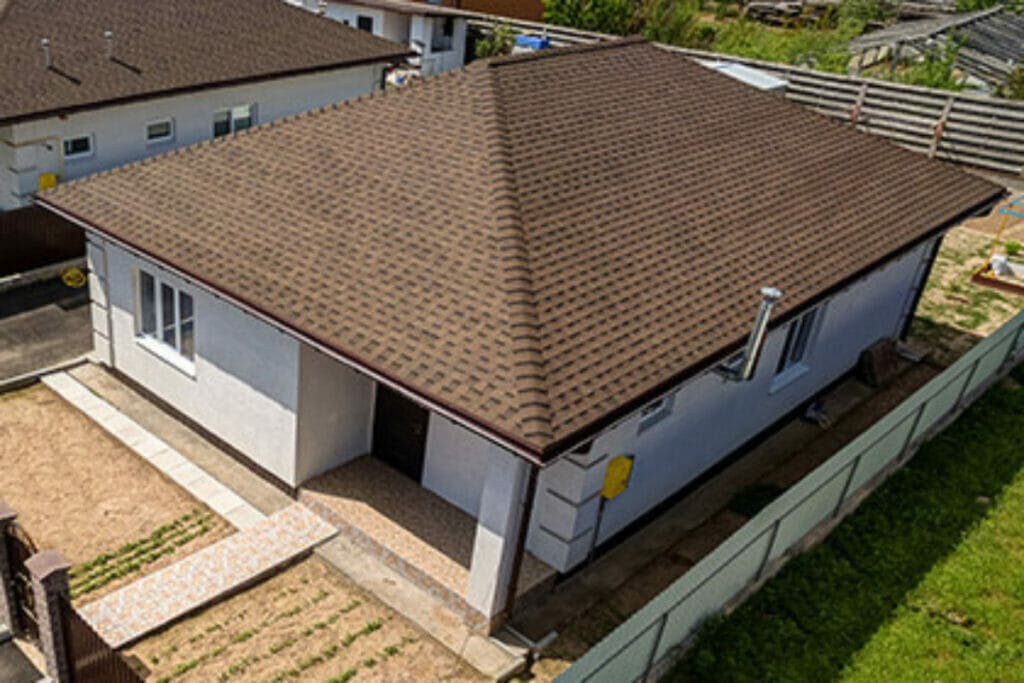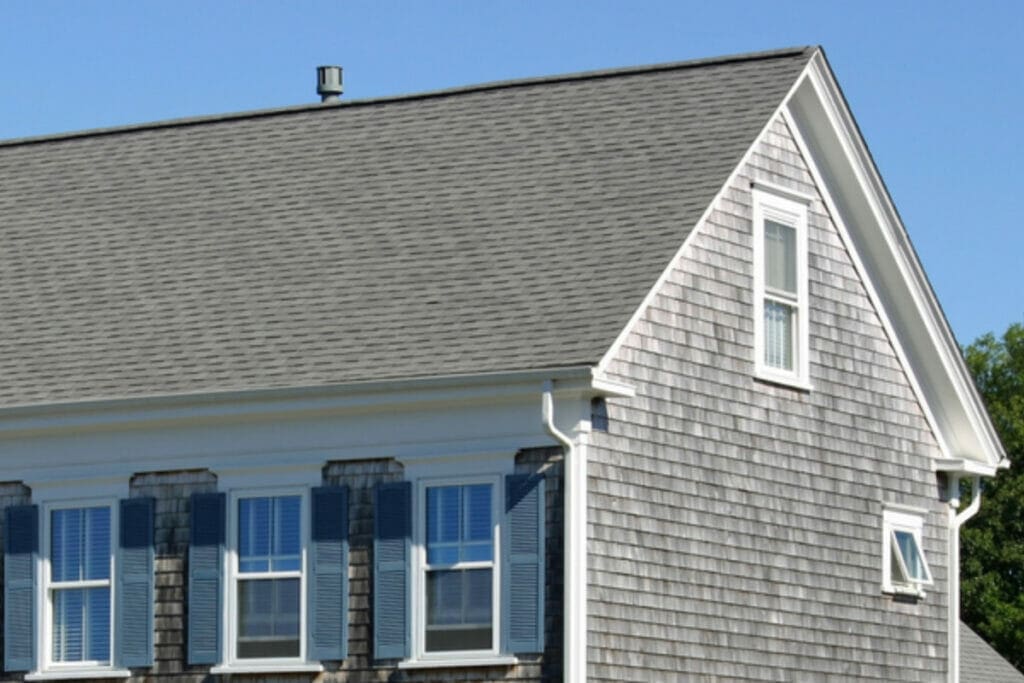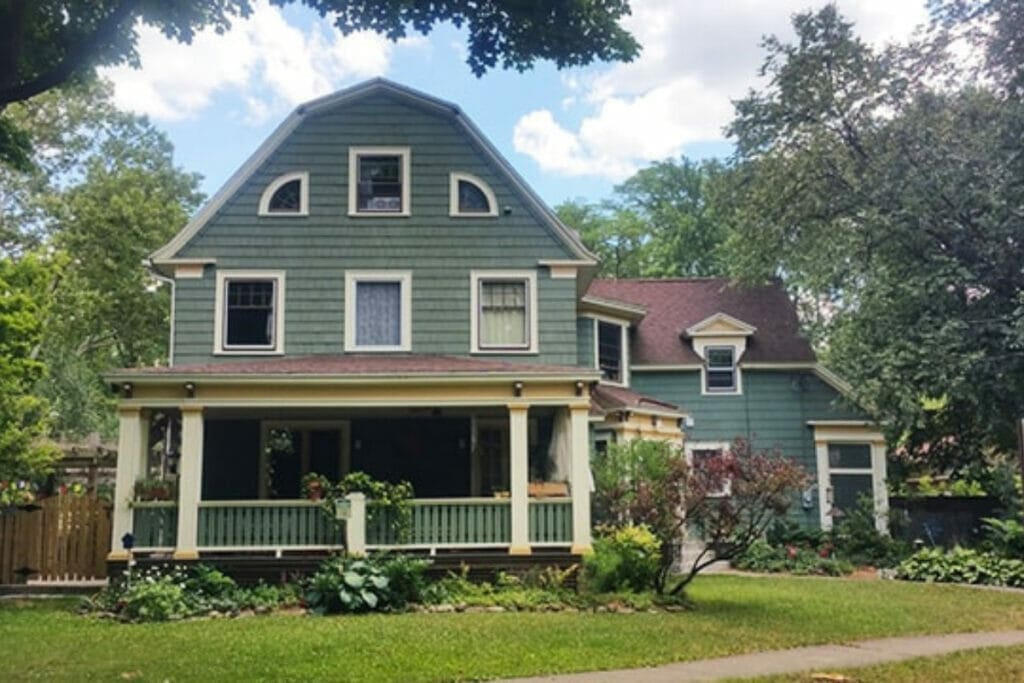If you’re tired of worrying about your roof during a weather event with high winds and want to better protect your home or building, choosing the right roof shape will make all the difference. In this blog post, we’ll explore the best roof shapes to resist high winds, and the ones to avoid. Whether you’re a homeowner or a commercial building owner, understanding the best roof shape for high winds, and the factors that contribute to roof wind damage, will help you make a better decision. So, let’s dive in and explore the best roof shapes resistant to high winds.
What Constitutes High Winds?
Typical day-to-day wind usually doesn’t exceed more than 8 miles per hour and it comes in the form of a light breeze. Depending on weather conditions and your geographical location, light breezes can turn into high winds that transform into a highly destructive force, wreaking havoc on your home or commercial building. Strong gusts have the potential to cause damage by displacement, tearing, or ripping away of the roofing material. Typically, high winds move at speeds ranging from 40 to 65 miles per hour. However, speeds can exceed 80 miles per hour, especially in locations prone to hurricanes.
Understanding How High Winds Damage Roofs

Winds are, in essence, air moving due to pressure differences between two regions. Air tends to move from high-pressure regions to low-pressure regions, with average speeds generally ranging from 8 to 20 miles per hour. However, this isn’t always the case, and wind speeds can become exceptionally high when there are significant changes in the pressure gradient between two points.
The more substantial the pressure difference, the more likely you are to experience high winds.
The destructive nature of high winds can be explained using Bernoulli’s principle, which states that as the speed of a fluid or gas (in this case, air) increases, its pressure decreases, and vice versa.
When high winds blow over a rooftop, they create a low-pressure area above the roof. At the same time, the pressure under the roof is typically higher and stays consistent. Because air moves from areas of high pressure to low pressure, the air beneath the roof pushes up on the roofing materials. This force can cause the materials to lift away from the building as the quicker, lower-pressure system moves past, pulling off roofing materials and causing damage.
The Science Behind Roof Shapes and Wind Resistance
The science behind different roof shapes and how they respond to high winds can be understood by the wind load. The wind load is the amount of force, in pounds, exerted by the wind on a roof. How much force winds exert on a roof depends on many factors, including wind speed and wind direction, the roof’s shape, slope, material, and the number of surrounding buildings.
The shape of a roof significantly influences how wind flows over and around it, resulting in areas of both low and high pressure. High pressure pushes down on the roof, while low pressure pulls up. This pressure difference creates an uplift force that can remove the roofing material if it isn’t properly secured.
Generally, roofs with multiple slopes and low pitches are more effective at minimizing wind load compared to roofs that expose a larger surface area to the wind. The type and quality of roofing materials also play a crucial role in withstanding wind load. For instance, heavier materials such as tiles or slate are less likely to be affected by high winds compared to lighter materials like asphalt shingles.
The building’s height is another important consideration. The taller the structure, the more wind load it is likely to experience due to increased exposure.
The presence of other buildings and structures can also impact the wind load on a roof. For example, buildings in a densely populated urban environment may be somewhat shielded from the wind by surrounding structures, while a standalone building in a rural or suburban setting may bear the full brunt of the wind.
The wind’s direction also affects how it interacts with the roof. A gable roof, for example, can experience high pressure when the wind hits it perpendicularly along the ridge line and low pressure when the wind flows parallel to the ridge line. Conversely, hip roofs, with their sloping sides, distribute the wind load across all four sides of the roof regardless of wind direction. This design eases the passage of wind over the roof’s surface, potentially reducing the risk of damage.
Best Roof Shapes For Wind Resistance
1. Hip Roofs
Hipped roofs have four slopes that meet at a ridge line. A hipped roof is ideal for high winds as it has no gable ends that can catch the wind and create an uplift.
A gable end, which is the triangular wall section at the end of a pitched roof, can create a low-pressure zone above the roof and a high-pressure zone below the roof when the wind blows against it. This pressure difference can cause roofing materials to lift away from the house, which isn’t the case in hipped roofs. By having slopes on all sides of the home, a hipped roof avoids this problem.
Hipped roofs also have a lower pitch that reduces the wind load on the roof’s surface. A low pitch means that the roof is less exposed to the wind and less likely to be damaged. The low pitch and the multiple slopes of a hipped roof enhance the stability and strength of the house by distributing the weight evenly over each side. Hipped roofs are, therefore, a good choice for areas that experience frequent high winds.

Advantages of Hipped Roofs
Durability
Although hipped roofs require more time to design, and more material and labor to construct, they generally turn out to be more durable than other roof types. They can withstand strong winds, heavy rain, and other extreme weather conditions, making them a popular choice for buildings in wind-prone areas.
Aerodynamic Shape
The sloping design of hipped roofs creates an aerodynamic shape that allows wind to flow smoothly over the roof without creating significant uplift or pressure. This reduces the wind load on the roof and the potential for damage.
2. Mansard Roofs
With a mansard roof, the steep lower slope can help distribute wind loads more evenly across the roof structure, which can help to reduce the likelihood of damage to the roof or the building. The lower slope can also act as a barrier to the wind, which can help to reduce the force of uplift that may pull the roofing materials off the building.
On the other hand, a mansard roof’s upper slope helps reduce wind drag and the pressure difference between the inside and outside of the roof. This can help reduce the uplift forces acting on the roof and the parallel forces that can push against the roof and cause it to shift or collapse.

Advantages of Mansard Roofs In Windy Areas
Better Wind Resistance
The design of a mansard roof offers several advantages that make it an ideal choice for a wind-resistant roof. The lower slope of a mansard roof is steeper, almost vertical, while the upper slope, which is not usually visible from the ground, is much lower. This design provides a lower profile for the wind to catch on, thereby reducing the risk of wind damage.
Easy to Maintain
In addition to its better wind resistance and increased living space, a mansard roof also offers the advantage of being easy to maintain. This is due to its simple and symmetrical design, which makes it easy to clean gutters and perform regular roof inspections. The flat top of the mansard roof also provides a stable platform for workers to access the roof for maintenance purposes.
3. Flat Roofs

Flat roofs, contrary to what homeowners might initially assume, have several characteristics that make them well-suited for handling high winds. Primarily, their low-profile design presents a smaller surface area for the wind to impact, thereby reducing the pressure exerted on the roof and the risk of wind uplift. Moreover, due to the absence of slopes or angles, there are fewer areas where wind can catch and cause damage.
High-quality, wind-rated membrane materials commonly used for flat roofs also enhance their resistance to wind damage, specifically TPO and PVC. Furthermore, when properly installed and secured, a flat roof system can distribute wind loads evenly across the roof surface, further enhancing its wind resistance. However, regular maintenance and quick repair of any damage, such as punctures or tears in the roofing material, are crucial to preserving a flat roof’s resilience against high winds.
Roof Shapes You Should Avoid
1. A Gable Roof

Gable roofs, while popular due to their simple, cost-effective design, are not the ideal choice for high-wind areas primarily due to their shape. A gable roof, with its triangular shape, presents a large, flat surface for wind to impact. In high wind conditions, this can cause an uplift effect, where the wind pressure beneath the roof tries to lift roofing materials off the structure.
If the gable ends are not adequately braced, they can act as sails, catching wind and potentially leading to structural failure. Additionally, gable roofs often lack the aerodynamic qualities found in other designs such as hip roofs, which allow wind to more easily flow over the surface rather than pushing against it. For these reasons, gable roofs require careful design, construction, and reinforcement when used in regions prone to high winds or hurricanes.
Check out our blog post on whether a gable roof or hip roof is better, for more information
2. A Gambrel Roof

Gambrel roofs, often associated with traditional barns or Dutch Colonial architecture, are not typically the best choice for areas prone to high wind gusts. The reason lies in their distinctive two-slope design: the upper slope is shallow, while the lower one is steeper and more pronounced. This gives the roof a broad, generally flat face on either side, which can act like a sail in high winds, catching and holding the wind instead of allowing it to flow over the roof easily.
This shape can also lead to high wind pressure on the lower, steeper portion of the roof, resulting in potential uplift forces that can cause damage or, in extreme cases, roof failure.
Other Factors That Contribute to Roof Wind Damage
1. Roof Slope
The slope of a roof can significantly impact its ability to withstand high winds. Steep slope roofs are more prone to wind uplift because high winds can get under the overhangs and lift the roofing material, especially if it is not properly secured. Low-slope roofs provide less opportunity for this to happen, but can still be affected by wind-driven rain and debris that can potentially damage the roofing material.
2. The Roof’s Material and Quality
The type of roofing material on your roof, and its quality, can also play a role in whether your roof is damaged by the wind. Durable, high-quality materials such as metal, concrete tiles, and cedar shingles, are more resistant to wind damage compared to less durable materials such as asphalt shingles.
3. The Building’s Height and Location
Tall buildings are more vulnerable to high winds than shorter buildings, as they experience stronger wind speeds at higher elevations. Buildings located in areas with frequent high winds, such as coastal areas or areas prone to tornadoes, may also be more vulnerable to wind damage.
4. The Surrounding Buildings and Terrain
The surrounding buildings and terrain can also affect wind patterns and the susceptibility of a building to wind damage. Buildings located in open areas or on hilltops may be more vulnerable to high winds, while buildings surrounded by other structures may be sheltered from wind damage.
5. Roof Installation
The proper installation of a roof is critical to its ability to withstand high winds. Improperly installed roofs may have weak spots or gaps that can allow wind to penetrate and cause damage. It is crucial to hire a professional contractor with experience in installing roofs in high-wind areas to ensure proper installation.
6. Maintenance
Regular roof maintenance is also important in preventing wind damage. Regular inspections can identify any weak spots or areas of concern before they become larger problems.
Hire Skilled and Professional Roofers For a Windproof Roof Installation
If you want a roof for your home or business that can withstand high wind gusts, hire a professional team of roofers to handle the job. Since proper installation is one factor that can protect your roof from wind damage, hiring unskilled roofers will be a waste of time and resources. This will also lead to a need for additional repairs and potential replacement in the long run. Therefore, call Champion Exteriors in New Jersey today, at (609) 845-3576 for a roof installation that can handle high winds, and other weather-related events.


